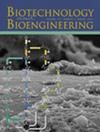Protein Engineering for Enhancing Electron Transfer in P450‐Mediated Catalysis
IF 3.5
2区 生物学
Q2 BIOTECHNOLOGY & APPLIED MICROBIOLOGY
引用次数: 0
Abstract
Cytochrome P450 enzymes (P450s) are versatile biocatalysts with applications spanning pharmaceutical development and natural product biosynthesis. A critical bottleneck in P450‐mediated reactions is the electron transfer process, which often limits catalytic efficiency and promotes uncoupling events leading to reactive oxygen species (ROS) formation. This review comprehensively examines recent protein engineering strategies aimed at enhancing electron transfer efficiency in P450 systems. We explore the design and application of different fusion constructs, which improve proximity between the P450 enzyme and its redox partners (RPs), as well as scaffold‐mediated protein assembly, enabling precise spatial organization of P450s and RPs. Furthermore, we discuss targeted modifications at the P450‐RP interaction interface and optimization of electron transfer pathways through site‐directed mutagenesis and directed evolution. These strategies enhance catalytic activity, improve coupling efficiency, and reduce ROS formation. Finally, we address the remaining challenges in understanding and engineering P450 electron transfer, and discuss the future directions, emphasizing the need for advanced computational modeling, structural characterization, and integration of synthetic and systems biology approaches.增强P450介导催化中电子转移的蛋白质工程
细胞色素P450酶(P450)是一种用途广泛的生物催化剂,应用于药物开发和天然产物生物合成。P450介导反应的一个关键瓶颈是电子转移过程,这通常限制了催化效率,并促进了导致活性氧(ROS)形成的解偶联事件。本文综述了最近旨在提高P450系统电子传递效率的蛋白质工程策略。我们探索了不同融合结构的设计和应用,这些融合结构可以改善P450酶与其氧化还原伙伴(RPs)之间的接近性,以及支架介导的蛋白质组装,从而实现P450酶和RPs的精确空间组织。此外,我们还讨论了P450 - RP相互作用界面的靶向修饰以及通过位点定向诱变和定向进化优化电子传递途径。这些策略增强了催化活性,提高了偶联效率,减少了ROS的形成。最后,我们解决了理解和工程P450电子转移的剩余挑战,并讨论了未来的方向,强调需要先进的计算建模,结构表征以及合成和系统生物学方法的集成。
本文章由计算机程序翻译,如有差异,请以英文原文为准。
求助全文
约1分钟内获得全文
求助全文
来源期刊

Biotechnology and Bioengineering
工程技术-生物工程与应用微生物
CiteScore
7.90
自引率
5.30%
发文量
280
审稿时长
2.1 months
期刊介绍:
Biotechnology & Bioengineering publishes Perspectives, Articles, Reviews, Mini-Reviews, and Communications to the Editor that embrace all aspects of biotechnology. These include:
-Enzyme systems and their applications, including enzyme reactors, purification, and applied aspects of protein engineering
-Animal-cell biotechnology, including media development
-Applied aspects of cellular physiology, metabolism, and energetics
-Biocatalysis and applied enzymology, including enzyme reactors, protein engineering, and nanobiotechnology
-Biothermodynamics
-Biofuels, including biomass and renewable resource engineering
-Biomaterials, including delivery systems and materials for tissue engineering
-Bioprocess engineering, including kinetics and modeling of biological systems, transport phenomena in bioreactors, bioreactor design, monitoring, and control
-Biosensors and instrumentation
-Computational and systems biology, including bioinformatics and genomic/proteomic studies
-Environmental biotechnology, including biofilms, algal systems, and bioremediation
-Metabolic and cellular engineering
-Plant-cell biotechnology
-Spectroscopic and other analytical techniques for biotechnological applications
-Synthetic biology
-Tissue engineering, stem-cell bioengineering, regenerative medicine, gene therapy and delivery systems
The editors will consider papers for publication based on novelty, their immediate or future impact on biotechnological processes, and their contribution to the advancement of biochemical engineering science. Submission of papers dealing with routine aspects of bioprocessing, description of established equipment, and routine applications of established methodologies (e.g., control strategies, modeling, experimental methods) is discouraged. Theoretical papers will be judged based on the novelty of the approach and their potential impact, or on their novel capability to predict and elucidate experimental observations.
 求助内容:
求助内容: 应助结果提醒方式:
应助结果提醒方式:


